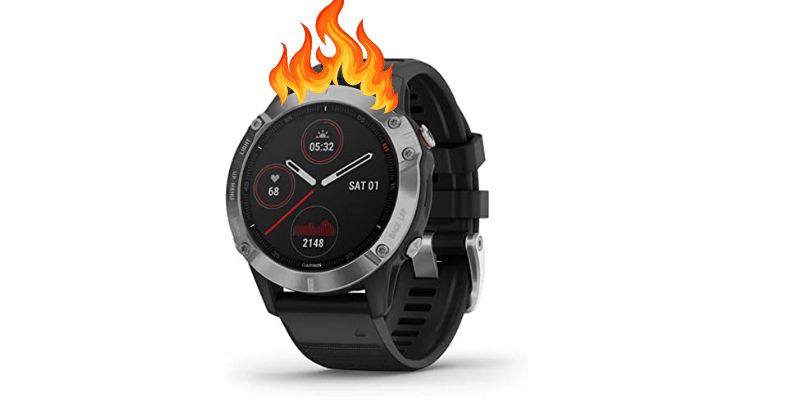
I was on my daily run and noticed my Garmin watch felt quite warm on my wrist. At first, I shrugged it off, thinking it was just the weather, but as the run went on, the overheating became more and more intense.
By the end of my run, my watch was so hot that it was actually burning my skin. I was disappointed and frustrated as I had invested much money in this high-end watch and expected it to perform better.
And then, I started researching to fix this issue. As I dug deeper, I found that many other users were facing the same issue and were looking for ways to fix it.
I read through forums and articles and even reached out to the manufacturer for help. After hours of research and experimentation, I finally found some solutions that helped fix it.
If you are facing the same problem, don’t worry; we will discuss how you can fix it.
So, let’s get started!
Garmin Watch Overheating While Charging

There are a few reasons why a Garmin watch might overheat while charging. One reason could be related to the power supply.
If the power supply is faulty or not rated for the specific device, it can cause the watch to overheat.
Another reason could be an improper connection with the charger. A loose connection can cause the watch to not charge properly, resulting in overheating.
Additionally, using a non-original or non-certified charger can also cause overheating.
How to Fix
When experiencing overheating issues with a Garmin watch while charging, a few steps can be taken to fix the problem.
First, check the power supply to ensure that it is providing enough power. Low voltages can cause the watch to overheat.
It is crucial to ensure that the power supply is compatible with the watch and not overloaded.
Second, check the connection between the charger and the watch. Ensure that the charger is securely connected from both ends.
Sometimes, a loose connection can cause the watch to not charge properly, resulting in overheating.
Unplugging and replugging the charger can help ensure that it is firmly connected to both the watch and the power source.
Lastly, use the original charger that is designed for your specific model of Garmin watch. Using non-original or non-certified chargers can also cause overheating.
The overheating issue can often be resolved by ensuring that the power supply is providing enough power, the connection is secure, and the original charger is being used.
Garmin Watch Overheats In Sun
There are a few reasons why a Garmin watch might overheat when exposed to the sun. One of which is the operating temperature of the watch.
The operating temperature range of a Garmin watch is typical -20°C to 60°C (-4°F to 140°F). When the temperature exceeds this range, it can cause the watch to overheat.
It’s essential to remember that, like the human body, electronic devices are also affected by heat.
When the temperature of a device exceeds its design limit, the internal components can malfunction and cause overheating.
Another reason is leaving the watch exposed to direct sunlight for an extended period.
The sun’s rays can cause the watch to heat up, and if it’s not able to cool down, it can cause overheating.
The sun’s heat can affect the watch’s temperature, and the heat generated by the watch itself causes it to overheat.
How to Fix
Here are some possible solutions to prevent a Garmin watch from overheating in the sun:
- Avoid exposing the watch to high temperatures: If possible, avoid using the watch in extreme temperatures, especially temperatures that exceed the operating temperature range (-20°C to 60°C or -4°F to 140°F)
- Keep the watch ventilated: Avoid covering it with clothing or other materials that can trap heat and prevent it from dissipating.
- Monitor the temperature of the watch: Keep an eye on the watch’s temperature; if it starts to feel hot, take it off and let it cool down.
- Use the watch at a moderate temperature: The best temperature for a watch is between -20°C to 60°C.
If the watch is still overheating, you may need to contact a professional technician or Garmin customer support.
Garmin Watch Overheating While Wearing
If your Garmin watch overheats while worn on the wrist, there are a few other reasons. One reason could be a defective battery.
A battery that is not functioning correctly can cause the watch to overheat. This could be due to a manufacturing defect, or it could be caused by prolonged use.
Another reason could be overusing the watch. If the watch is being used excessively or for prolonged periods.
It can cause the internal components to heat up and lead to overheating.
This is because the watch runs at full power for an extended period, which can cause the internal temperature to rise.
Additionally, a software malfunction or an update that could cause the watch to work harder than usual may cause overheating.
This can happen if the watch runs too many apps or constantly receives data from the GPS or other sensors.
How to Fix
Here are some possible solutions to prevent a Garmin watch from overheating while worn on the wrist:
- Monitor the usage of the watch: Avoid overusing the watch and limit the time it is worn on the wrist.
- Monitor the battery status: Keep an eye on the watch’s battery status and ensure it is not running low. When the battery is low, it can cause the watch to work harder, resulting in overheating.
- Check for software updates: Ensure that the watch’s software is up to date. Outdated software or software malfunction can cause the watch to work harder than usual, which can cause overheating.
Garmin Watch Overheating After Swimming
One of the reasons is water exposure. Many Garmin watches, such as Forerunner, Swim, Epix, Enduro, Fenix, Decent, Instinct, Quatix, Tactix, and Venu, are water-resistant and can be worn while showering or swimming.
However, as with any electronic device, their water resistance capabilities can diminish over time.
Another reason is the watch has not been correctly dried after swimming. If the watch is not properly dried, water can seep into it and cause it to overheat.
Additionally, if the watch has been damaged or exposed to too cold or too warm water, it can cause the watch to overheat.
How to Fix
Here are some possible solutions to prevent a Garmin watch from overheating after swimming:
- Check the water-resistant rating: Before swimming with the watch, check the user manual and ensure that the watch has a water-resistant rating that allows it to be worn while swimming.
- Dry the watch properly: After swimming, ensure to dry the watch thoroughly, including the ports and buttons, to prevent water from seeping in and causing overheating.
- Avoid exposing the watch to extreme temperatures: Avoid exposing the watch to cold or hot water, as the temperature can cause the watch to overheat.
Contact Customer Support
If you have tried the solutions suggested above and the overheating issue with your Garmin watch still persists, it may be necessary to contact customer support.
Garmin has a dedicated team of customer support representatives who are trained to help troubleshoot and resolve issues with their products.
Conclusion
In conclusion, overheating issues with a Garmin watch can be caused by various factors, including a defective battery, overuse, exposure to extreme temperatures, and water damage.
To prevent and fix overheating issues, it is essential to monitor the usage and battery status of the watch, ensure that it is properly dried after swimming, and avoid exposing it to extreme temperatures.
If the overheating issue persists, it is important to contact Garmin customer support for further assistance.
Read Also:
Garmin Watch Time wrong (Fixed)
Garmin Forerunner 235 Time Wrong (How to Fix)
Garmin Forerunner 235 Keep Connecting and Disconnecting (Fixed)
How to Connect Garmin Watch to iFIT
Can Garmin Watch Connect to Peloton (Answered)
How to reset Garmin Forerunner 35
Inkcue brings to you the latest and best in tech industry with reviews, buyer’s guide, technical know-how and problem solving. Our aim is to provide a one-stop guide to all your technological needs and to simplify the process of purchasing them. Cheers Amigos!
